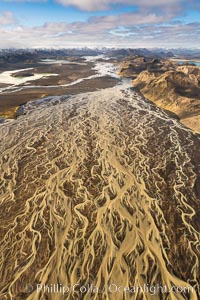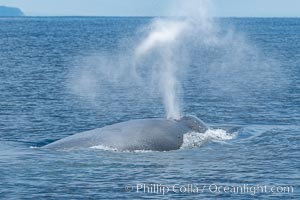
Blue whale, exhaling in a huge blow as it swims at the surface between deep dives. The blue whale's blow is a combination of water spray from around its blowhole and condensation from its warm breath.
Species: Blue whale, Balaenoptera musculus
Location: San Diego, California
Image ID: 34560
Species: Blue whale, Balaenoptera musculus
Location: San Diego, California
Image ID: 34560
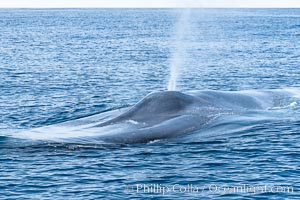
Blue whale, exhaling in a huge blow as it swims at the surface between deep dives. The blue whale's blow is a combination of water spray from around its blowhole and condensation from its warm breath.
Species: Blue whale, Balaenoptera musculus
Location: San Diego, California
Image ID: 34564
Species: Blue whale, Balaenoptera musculus
Location: San Diego, California
Image ID: 34564
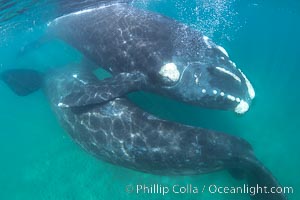
Courting pair of southern right whales underwater, Eubalaena australis. In this image, the male is below and inverted (belly up) and the female is at the surface. While the posture in this photo isn't quite mating, it is a courting behavior that often precedes mating.
Species: Southern Right Whale, Eubalaena australis
Location: Puerto Piramides, Chubut, Argentina
Image ID: 38295
Species: Southern Right Whale, Eubalaena australis
Location: Puerto Piramides, Chubut, Argentina
Image ID: 38295
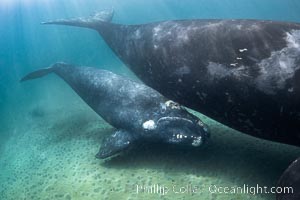
Southern right whale mother and calf underwater, Eubalaena australis.
Species: Southern Right Whale, Eubalaena australis
Location: Puerto Piramides, Chubut, Argentina
Image ID: 38305
Species: Southern Right Whale, Eubalaena australis
Location: Puerto Piramides, Chubut, Argentina
Image ID: 38305
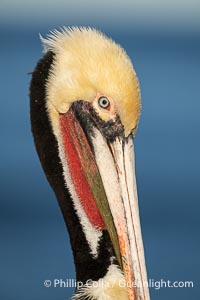
Study of a California brown pelican in winter breeding plumage, yellow head, red and olive throat, pink skin around the eye, brown hind neck with some white neck side detail.
Species: Brown Pelican, Pelecanus occidentalis, Pelecanus occidentalis californicus
Location: La Jolla, California
Image ID: 39871
Panorama dimensions: 8640 x 5760
Species: Brown Pelican, Pelecanus occidentalis, Pelecanus occidentalis californicus
Location: La Jolla, California
Image ID: 39871
Panorama dimensions: 8640 x 5760
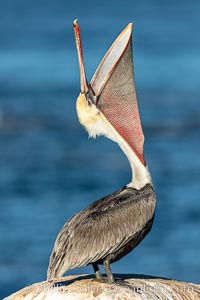
California Brown Pelican head throw, stretching its throat to keep it flexible and healthy. Note the winter mating plumage, olive and red throat, yellow head.
Species: Brown Pelican, Pelecanus occidentalis, Pelecanus occidentalis californicus
Image ID: 36606
Species: Brown Pelican, Pelecanus occidentalis, Pelecanus occidentalis californicus
Image ID: 36606
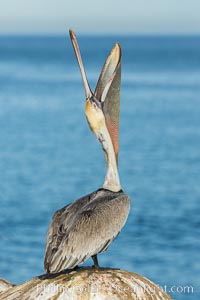
California Brown Pelican head throw, stretching its throat to keep it flexible and healthy. Note the winter mating plumage, olive and red throat, yellow head.
Species: Brown Pelican, Pelecanus occidentalis, Pelecanus occidentalis californicus
Location: La Jolla, California
Image ID: 30327
Species: Brown Pelican, Pelecanus occidentalis, Pelecanus occidentalis californicus
Location: La Jolla, California
Image ID: 30327
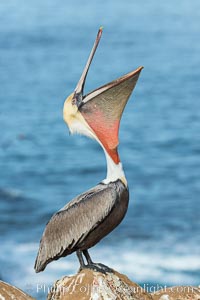
California Brown Pelican head throw, stretching its throat to keep it flexible and healthy. Note the winter mating plumage, olive and red throat, yellow head.
Species: Brown Pelican, Pelecanus occidentalis, Pelecanus occidentalis californicus
Location: La Jolla, California
Image ID: 30339
Species: Brown Pelican, Pelecanus occidentalis, Pelecanus occidentalis californicus
Location: La Jolla, California
Image ID: 30339
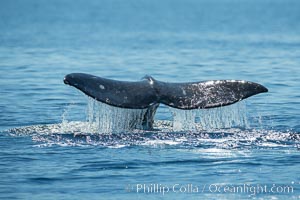
Gray whale raising fluke before diving, on southern migration to calving lagoons in Baja.
Species: Gray whale, Eschrichtius robustus
Location: San Diego, California
Image ID: 30463
Species: Gray whale, Eschrichtius robustus
Location: San Diego, California
Image ID: 30463
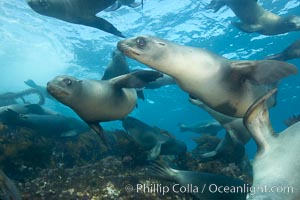
California sea lions, underwater at Santa Barbara Island. Santa Barbara Island, 38 miles off the coast of southern California, is part of the Channel Islands National Marine Sanctuary and Channel Islands National Park. It is home to a large population of sea lions.
Species: California sea lion, Zalophus californianus
Location: Santa Barbara Island, California
Image ID: 23422
Species: California sea lion, Zalophus californianus
Location: Santa Barbara Island, California
Image ID: 23422
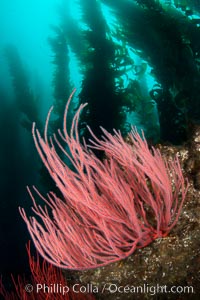
Red gorgonian on rocky reef, below kelp forest, underwater. The red gorgonian is a filter-feeding temperate colonial species that lives on the rocky bottom at depths between 50 to 200 feet deep. Gorgonians are oriented at right angles to prevailing water currents to capture plankton drifting by.
Species: Red gorgonian, Leptogorgia chilensis, Lophogorgia chilensis
Location: San Clemente Island, California
Image ID: 25394
Species: Red gorgonian, Leptogorgia chilensis, Lophogorgia chilensis
Location: San Clemente Island, California
Image ID: 25394
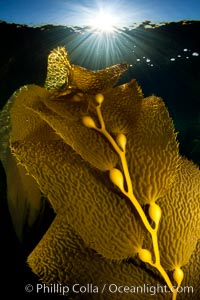
Kelp fronds and pneumatocysts. Pneumatocysts, gas-filled bladders, float the kelp plant off the ocean bottom toward the surface and sunlight, where the leaf-like blades and stipes of the kelp plant grow fastest. Giant kelp can grow up to 2' in a single day given optimal conditions. Epic submarine forests of kelp grow throughout California's Southern Channel Islands.
Species: Giant kelp, Macrocystis pyrifera
Location: San Clemente Island, California
Image ID: 25396
Species: Giant kelp, Macrocystis pyrifera
Location: San Clemente Island, California
Image ID: 25396
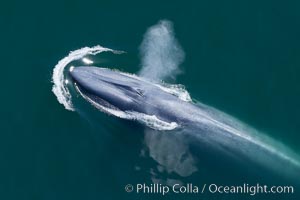
Blue whale, exhaling as it surfaces from a dive, aerial photo. The blue whale is the largest animal ever to have lived on Earth, exceeding 100' in length and 200 tons in weight.
Species: Blue whale, Balaenoptera musculus
Location: Redondo Beach, California
Image ID: 25953
Species: Blue whale, Balaenoptera musculus
Location: Redondo Beach, California
Image ID: 25953
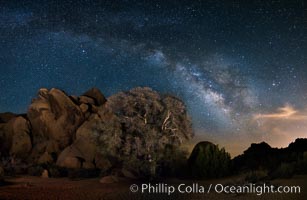
Live Oak and Milky Way, rocks and stars, Joshua Tree National Park at night.
Location: Joshua Tree National Park, California
Image ID: 28417
Panorama dimensions: 4848 x 7431
Location: Joshua Tree National Park, California
Image ID: 28417
Panorama dimensions: 4848 x 7431
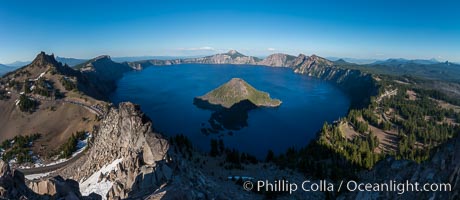
Panorama of Crater Lake from Watchman Lookout Station, panoramic picture. The Watchman Lookout Station No. 168 is one of two fire lookout towers in Crater Lake National Park in southern Oregon. For many years, National Park Service personnel used the lookout to watch for wildfires during the summer months. It is also a popular hiking destination because it offers an excellent view of Crater Lake and the surrounding area.
Location: Crater Lake National Park, Oregon
Image ID: 28633
Panorama dimensions: 4885 x 11229
Location: Crater Lake National Park, Oregon
Image ID: 28633
Panorama dimensions: 4885 x 11229
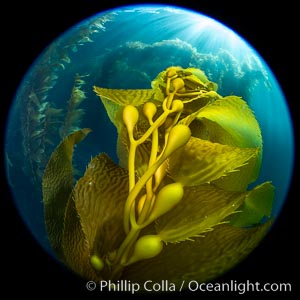
Kelp fronds and pneumatocysts. Pneumatocysts, gas-filled bladders, float the kelp off the ocean bottom toward the surface and sunlight, where the leaf-like blades and stipes of the kelp plant grow fastest. Catalina Island, California.
Species: Giant kelp, Macrocystis pyrifera
Location: Catalina Island, California
Image ID: 37282
Species: Giant kelp, Macrocystis pyrifera
Location: Catalina Island, California
Image ID: 37282
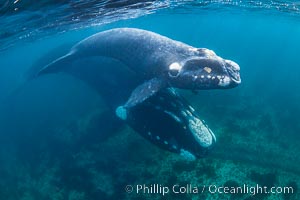
Southern right whale mother and calf underwater, Eubalaena australis.
Species: Southern Right Whale, Eubalaena australis
Location: Puerto Piramides, Chubut, Argentina
Image ID: 38310
Species: Southern Right Whale, Eubalaena australis
Location: Puerto Piramides, Chubut, Argentina
Image ID: 38310
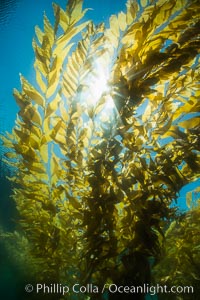
The Kelp Forest offshore of La Jolla, California. A kelp forest. Giant kelp grows rapidly, up to 2' per day, from the rocky reef on the ocean bottom to which it is anchored, toward the ocean surface where it spreads to form a thick canopy. Myriad species of fishes, mammals and invertebrates form a rich community in the kelp forest. Lush forests of kelp are found throughout California's Southern Channel Islands.
Species: Giant kelp, Macrocystis pyrifera
Image ID: 30986
Species: Giant kelp, Macrocystis pyrifera
Image ID: 30986
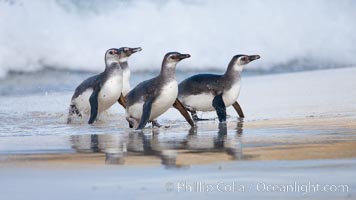
Magellanic penguins, coming ashore on a sandy beach. Magellanic penguins can grow to 30" tall, 14 lbs and live over 25 years. They feed in the water, preying on cuttlefish, sardines, squid, krill, and other crustaceans.
Species: Magellanic penguin, Spheniscus magellanicus
Location: New Island, Falkland Islands, United Kingdom
Image ID: 23924
Species: Magellanic penguin, Spheniscus magellanicus
Location: New Island, Falkland Islands, United Kingdom
Image ID: 23924
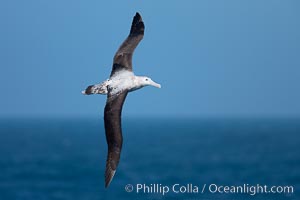
Wandering albatross in flight, over the open sea. The wandering albatross has the largest wingspan of any living bird, with the wingspan between, up to 12' from wingtip to wingtip. It can soar on the open ocean for hours at a time, riding the updrafts from individual swells, with a glide ratio of 22 units of distance for every unit of drop. The wandering albatross can live up to 23 years. They hunt at night on the open ocean for cephalopods, small fish, and crustaceans. The survival of the species is at risk due to mortality from long-line fishing gear.
Species: Wandering albatross, Diomedea exulans
Location: Southern Ocean
Image ID: 24071
Species: Wandering albatross, Diomedea exulans
Location: Southern Ocean
Image ID: 24071
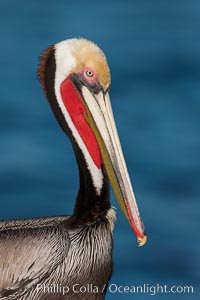
California brown pelican, showing characteristic winter plumage including red/olive throat, brown hindneck, yellow and white head colors.
Species: Brown Pelican, Pelecanus occidentalis, Pelecanus occidentalis californicus
Location: La Jolla, California
Image ID: 26463
Species: Brown Pelican, Pelecanus occidentalis, Pelecanus occidentalis californicus
Location: La Jolla, California
Image ID: 26463
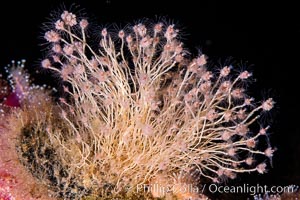
Unidentified likely hydroid, filtering nutrients from passing ocean currents, oil rigs, southern California.
Image ID: 35078
Image ID: 35078
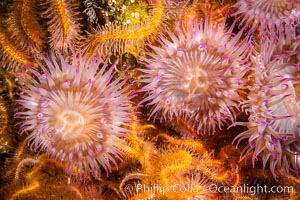
Aggregating anemones Anthopleura elegantissima on oil rigs, southern California.
Image ID: 35080
Image ID: 35080
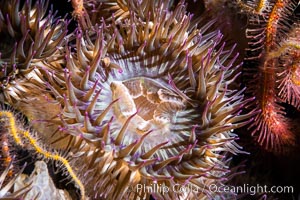
Aggregating anemones Anthopleura elegantissima on oil rigs, southern California.
Image ID: 35081
Image ID: 35081
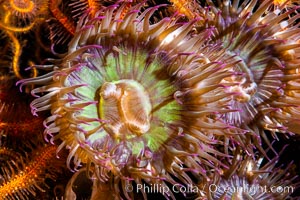
Aggregating anemones Anthopleura elegantissima on oil rigs, southern California.
Image ID: 35082
Image ID: 35082
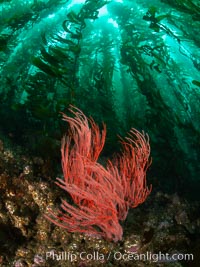
Red gorgonian on rocky reef, below kelp forest, underwater. The red gorgonian is a filter-feeding temperate colonial species that lives on the rocky bottom at depths between 50 to 200 feet deep. Gorgonians are oriented at right angles to prevailing water currents to capture plankton drifting by.
Species: Red gorgonian, Leptogorgia chilensis, Lophogorgia chilensis
Location: Santa Barbara Island, California
Image ID: 35825
Species: Red gorgonian, Leptogorgia chilensis, Lophogorgia chilensis
Location: Santa Barbara Island, California
Image ID: 35825
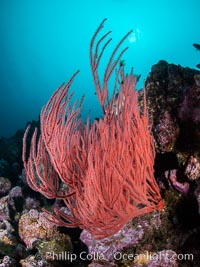
Red gorgonian on rocky reef, below kelp forest, underwater. The red gorgonian is a filter-feeding temperate colonial species that lives on the rocky bottom at depths between 50 to 200 feet deep. Gorgonians are oriented at right angles to prevailing water currents to capture plankton drifting by.
Species: Red gorgonian, Leptogorgia chilensis, Lophogorgia chilensis
Location: Santa Barbara Island, California
Image ID: 35828
Species: Red gorgonian, Leptogorgia chilensis, Lophogorgia chilensis
Location: Santa Barbara Island, California
Image ID: 35828
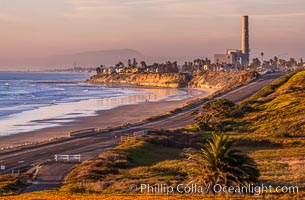
Carlsbad Coast Highway Sunset, Terramar and North Ponto to Oceanside with Camp Pendleton in the distance. Rising in the distance is San Onofre Mountain (1722') topped by a tall signal tower, one of the southern peaks in the Santa Ana Mountains.
Location: Carlsbad, California
Image ID: 35902
Location: Carlsbad, California
Image ID: 35902
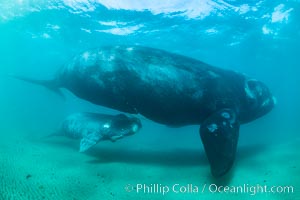
Southern right whale mother and calf, Eubalaena australis, Argentina.
Species: Southern right whale, Eubalaena australis
Location: Puerto Piramides, Chubut, Argentina
Image ID: 35918
Species: Southern right whale, Eubalaena australis
Location: Puerto Piramides, Chubut, Argentina
Image ID: 35918
